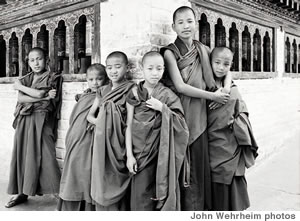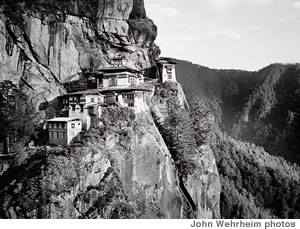Happiness, Bhutan-style
Is there anyone who would say no to happiness? Bhutan is a place where the government decided to make the governing rule about happiness - the Gross National Happiness. After all, Bhutan, which is isolated high in the Himalayas between China and India, has lush waterfalls, green forests, quaint villages and an active farming community.

By .(JavaScript must be enabled to view this email address)
E-mail this story | Print this page | Archive | RSS

|
Is there anyone who would say no to happiness? Bhutan is a place where the government decided to make the governing rule about happiness - the Gross National Happiness.
After all, Bhutan, which is isolated high in the Himalayas between China and India, has lush waterfalls, green forests, quaint villages and an active farming community.
Local veteran filmmakers Tom Vendetti, John Wehrheim and Robert Stone were among the first western filmmakers allowed in the country to share the story of Bhutan, which previously issued only 500 visas a year. The Oahu debut of their film, Bhutan: Taking The Middle Path To Happiness, screens Nov. 17 at the East-West Center and Nov. 18 at UHManoa.
Buddhism, which encourages happiness and believes suffering is unnecessary, is the official religion of Bhutan.
“There’s wisdom in other cultures around the world,” says Tom Vendetti, the film’s director and a psychologist at the Maui Mental Health Clinic. “I hope people can be open to change and a new paradigm. This film is a labor of love.”
Produced with the help of Scott Dewar with music by Christopher Hedge and Paul Horn, two weeks of filming capturing the essence of the land is edited into 60 minutes. Vendetti notes the film is about how people in Bhutan define happiness, feel content and are satisfied.
“There are four pillars that the government looks at to determine happiness,” he explains. “One is good government that is transparent, that the people can trust, and that represents the people. Two is the environment and preserving nature - we need the beauty of the birds, trees, streams and lakes. Three is preserving culture, as there is lots of wisdom in the people’s identity, which we hope does not get taken over by globalization. Four is economic stability, which they are doing with hydroelectric power.”
The country developed hydro-electric power plants that are hidden underground so that the prevailing features of the land are its natural beauty. The film says that about 40 percent of the government’s income comes from hydroelectric power, and that they have much more they can do to utilize this resource.
Vendetti says one of the difficulties of shooting this documentary was filming in remote areas and at high altitudes. The footage is of various traditional dances, native clothing, forests and rice fields.
Vendetti adds that time for your family and leisure time to enjoy nature are some the values emphasized in the documentary.

|
It was inspired in part by an exhibit of photos of Bhutan by Kauai resident John Wehrheim at the East-West Center. Wehrheim designs hydroelectric plants, and he had a consulting contract with Bhutan. The exhibit reignited Vendetti’s flame of interest in Bhutan, as he had heard of the mysterious country 20 years ago. The East-West Center is also where Vendetti and Wehrheim discussed over drinks how Bhutan native Thinley Coden could assist them with the film. Coden says she helped to present the film proposal to get the government’s permission to do the documentary. Coden, who owns Bhutan Tours and Travels agency with her sister, helped to set up interviews with the government officials. She consulted on cultural issues and is interviewed in the film. Coden, who got her master’s in public administration at the University of Hawaii at Manoa and is an East-West Fellow, acknowledges that modern influences are coming into Bhutan.
The film chronicles how the country has television, Internet and more modern influences, and how those influences are helping or harming the isolated country.
Coden, who lives in both the modern world that Hawaii - and her previous residence in Wisconsin - have to offer, says it is important to balance the new with the old.

|
“We are taking conscious steps,” she says about Bhutan. “We are not just opening the flood gates. We should do it slowly - one step at a time. We need to think about things in the long term. Don’t overdo it or under do it.”
With the influence of more television stations, advertising and the Internet in Bhutan, officials discussed how some of the values are affected. One official noted how a good woman who was judged by what she can accomplish in the field is now being compared to hour-glass-shaped makeup-wearing models.
The cinematic work also delves briefly into the urbanized parts of Bhutan where there are billboards, nightclubs and automobiles.
“Not that I’ve seen all the documentaries on Bhutan, but this is one of the better ones I’ve seen,” she says. “It’s the most upto-date and well-made, well-balanced in the way it portrays Bhutan.”
Wehrheim has a black-and-white companion photo book to this documentary called Bhutan: Hidden Land of Happiness, which is available online at http://www.serindia.com/item.cfm/171
Goen Tshering of Bhutan’s National Academy of Performing Arts will present a musical concert after the two film screenings. Bhutan: Taking The Middle Path To Happiness screens at 7:30 p.m. Nov. 17 at the East West Center, Imin International Conference Center, Keoni Auditorium, and 5 p.m. Nov. 18 at the UH-Manoa Spalding Auditorium in Association with Hawaii Filmmaker Showcase. Tickets are $20 and are available online at www.Bhutanfilm.com
Page 1 of 1 pages for this story
E-mail this story | Print this page | Comments (0) | Archive | RSS
Most Recent Comment(s):








